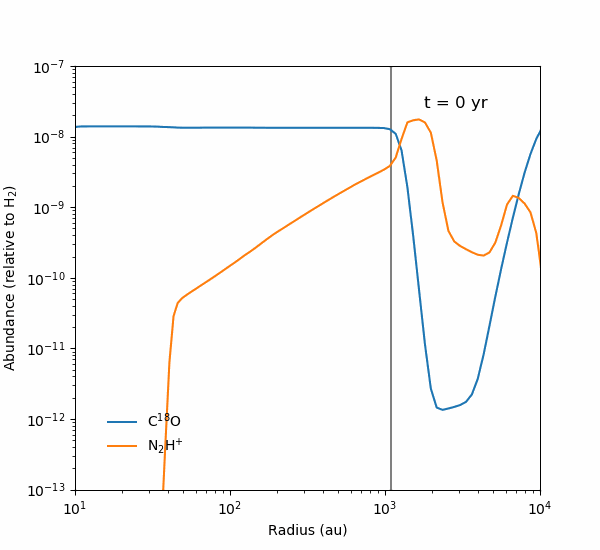Back in 2016, Sibylle Anderl, myself, and our colleagues from the CALYPSO team, studied the carbon monoxide snow line in a sample of Class 0 protostars. As explained in a a previous post, we looked for the snow line of carbon monoxide by observing C18O, an isotopologue of this molecule, directly. But the CO-snow line is also traced by another molecule: diazenylium, N2H+. This species is chemically destroyed by CO and should therefore form a ring outside the region where CO is present in the gas. This pattern, a circular region of C18O emission and an adjacent ring of N2H+, was indeed observed in several protostars of our sample. But to our surprise, it turned out that the situation was different in one of the sources, IRAM 04191+24211 (IRAM 04191 for short).
IRAM 04191 is what is called a “very low luminosity object” (a “VeLLO”). If a mass accretion rate is derived from its observed low luminosity, it looks like IRAM 04191 is not going to reach a final mass sufficient to become a proper low mass star. Instead it would become a brown dwarf, a substellar object heavier than gas giants but not heavy enough to start nuclear fusion of hydrogen. In this source, the N2H+ (1-0) line emission forms a partial ring, with an inner radius of about 1100 astronomical units (au). The C18O emission is located much closer to the protostar, within a radius of about 70 au (see Fig. 1).
Figure 1: Maps of the N2H+ (left panel) and C18O (right panel) line emission observed with the NOEMA interferometer towards IRAM 04191. The white solid circle shows the position of the CO-snowline at the present day, while the dotted circle (left panel) shows the snowline as it was during the luminosity burst. The N2H+ emission is detected at much farther distance from the protostar than C18O. The white lines in the bottom left corners of each plot show the physical scales in astronomical units. The ellipses in the bottom right corners show the angular resolution of the observations. Adapted from Anderl et al. (2020). The contours show the 3, 6, 9 and 12σ emission levels.
Using numerical models of the protostellar envelope and its chemistry, we could show that this peculiar chemical pattern can be explained if the luminosity of IRAM 04191 had changed in the past. This conclusion uses the fact that chemistry can be used to look back in time. Because chemical reactions take a certain amount of time, sometimes chemical pattern still trace physical conditions that since have long changed. So when IRAM 04191 had a luminosity outburst in the past, the temperature in the surrounding cloud was higher and the snow line was further out, as it is still traced by N2H+. When the burst was over, the temperature went down again. But while CO was fast to be bound in ices again, the reformation of N2H+ in the gas phase took longer even though there was no CO anymore to destroy it: Thus the observed gap between C18O and N2H+. This is illustrated in Fig. 2, that shows the predicted C18O and N2H+ as a function of time since the end of the outburst.

Figure 2: Predicted N2H+ and C18O abundances in IRAM 04191 as a function of time since the luminosity burst. The vertical line indicate the radius of the carbon monoxide snowline. Adapted from Anderl et al. (2020).
According these models, the luminosity burst should have occurred no longer than a thousand years ago from now and made IRAM 04191 shine more than 150-fold as luminous as it appears today. Assuming that bursts like this happen roughly every 13,000 years as indicated by models and observations, this means that IRAM 04191 will indeed be able to reach a final mass of about 20 percent that of the Sun – and become a proper low mass star. The result demonstrates that the accretion history of very young protostars can be very dynamic.
The paper “Probing episodic accretion with chemistry: CALYPSO observations of the very-low-luminosity Class 0 protostar IRAM 04191+1522” by Anderl et al. is available on arXiv.
Background image credit: IRAM, D. Joubert and J.-P. Kornmann.
